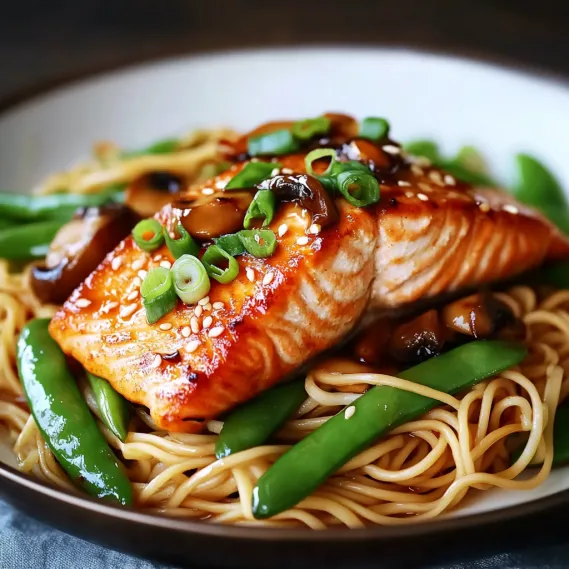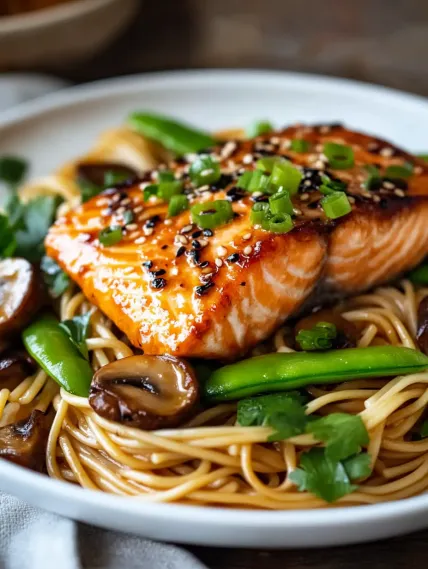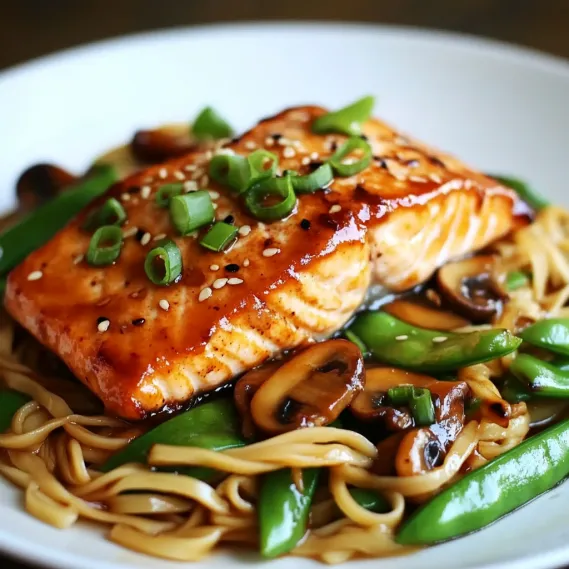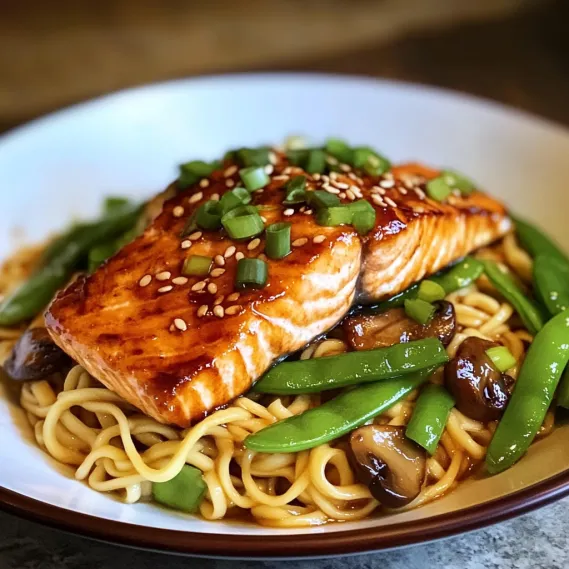 Pin it
Pin it
Dive into this mouth-watering mix of sweet meets spicy in our Asian Salmon and Noodles creation. The juicy salmon gets a perfect honey-soy coating that works wonderfully with the Sriracha-kicked noodles packed with mushrooms and crunchy snow peas. This Asian-inspired combo brings together amazing flavors in a dish that's super easy to make but tastes like you ordered takeout.
I stumbled onto this dish during a time when I wanted to get more fish into our family's diet. My husband always said salmon was 'too fishy' for his liking, but the sweet glaze and tasty noodles in this meal totally changed his mind. Now he asks for it all the time, which feels like I've won some kind of cooking championship at home.
Key Ingredients and Shopping Advice
- Salmon Fillets: Go for middle cuts with the same thickness so they cook evenly. Wild-caught tastes amazing, but farm-raised is fine too.
- Soy Sauce: Pick low-sodium if you're cutting back on salt. Try tamari if you can't have gluten.
- Honey: Buying local can add nice flavor touches to your dish. Its sweetness works great against the salty soy.
- Sriracha: Brings just enough kick without taking over. Start small if you don't like things too hot.
- Snow Peas: Look for ones that are bright green and full. They should break with a snap when you bend them.
I've found that spending a bit more on really good sesame oil makes a huge difference in this meal. A quality sesame oil adds this nutty, amazing smell to the whole sauce and gives you that real Asian restaurant taste that makes everybody love this dish.
Step-by-Step Cooking Guide
- Step 1: Start the Noodle Mix
- Warm up olive oil in a big pan over medium heat. Toss in green onions and sesame seeds, cooking for 2 minutes until they smell good but haven't browned. This creates the flavor base for your noodles.
- Step 2: Create the Tasty Sauce
- Throw mushrooms into the pan and let them cook about 2 minutes until slightly browned. Pour in your soy sauce, honey, chicken stock, sesame oil, and Sriracha, then mix it all up. Let it bubble gently to bring out all the flavors.
- Step 3: Get Your Veggies and Pasta Ready
- Boil your snow peas for around 5 minutes till they turn bright green with a slight crunch. Cook your fettuccine following the box directions until it's just right. Mix both with your sauce, giving everything a gentle toss.
- Step 4: Cook the Salmon Right
- Turn on your broiler. Rub salmon pieces with a bit of olive oil, salt, and pepper. Put them under the broiler with the flesh facing down for about 4 minutes until they get golden and slightly crispy. Flip them carefully and set them aside.
- Step 5: Whip Up a Simple Glaze
- Stir honey and soy sauce together in a small bowl until everything's mixed well. This combo gives you deep flavor without too much heat.
- Step 6: Add the Final Touch
- Turn the salmon over and brush on your honey-soy mix. Stick it back under the broiler for about 4 minutes until the glaze gets a bit caramelized. Take it out and let it sit briefly before serving with the noodles.
- Step 7: Time to Eat
- Put your glazed salmon on a nice plate and spoon plenty of sauce over the noodles. Sprinkle with fresh parsley and serve right away for the best taste.
 Pin it
Pin it
I found out how important it is to sear salmon properly after my first try left me with tough, rubbery fish. The line between perfect and overdone is just a few seconds. My big breakthrough happened when I started finishing the salmon under the broiler, getting that awesome crispy outside while keeping the inside moist and tender.
 Pin it
Pin it
Making Fantastic Noodles
The real trick to amazing noodles comes down to that layering method that builds those beautiful, separate layers. When I first tried making these, my layers would often blend together while frying, and I'd end up with something more like regular noodles. I learned you've got to be patient during the folding and cooling steps. Each time you let the dough chill in the fridge, the gluten gets a chance to relax while the butter firms up just enough to keep those layers separate. My big aha moment came when I started using a ruler to make sure I was rolling everything evenly and folding precisely. Now when I cut into a finished noodle, I get that gorgeous honeycomb pattern that shows perfect layering.
Getting the Filling Just Right
Finding that sweet spot between the vanilla bean cream and strawberry jam took me several tries to get right. At first, I used way too much jam, which covered up the gentle vanilla taste and made the noodles get soggy within hours. After trying different ways, I figured out that piping a big ring of vanilla bean cream first makes a solid base, with just a tiny bit of jam in the middle. This way both flavors shine through while keeping everything nicely structured.
Keeping Everything at the Right Temperature
Getting the temperature right throughout the process turns good noodles into amazing ones. During my early attempts, my kitchen was too warm and I constantly fought with butter that kept melting and leaking during the layering process. Now I keep a digital thermometer nearby to check both my dough and workspace. I've found that cooling the rolling pin and counter before each rolling session helps a ton during hot summer days. When frying, I use a deep-fry thermometer and constantly adjust the heat to keep the oil between 345°F and 355°F. This narrow temperature range makes sure the noodles puff up dramatically while cooking through perfectly without getting burned.
Ideas for Different Seasons
While our family loves the strawberry-vanilla combo the most, I've come up with seasonal versions that show how flexible this technique can be. In fall, I swap in apple butter and cinnamon cream, then roll the finished noodles in maple sugar. For Christmas morning, a chocolate cream with peppermint sugar creates a festive holiday treat. My spring version with lemon curd and blueberry jam has become super popular with friends, who always ask for it at brunch get-togethers when berries are fresh and plentiful.
Prep Ahead and Freezing Options
For busy families, this recipe works great as a make-ahead option. You can prepare the noodle squares up to twelve hours before cooking and keep them in an airtight container in the fridge. The glaze can be made a day ahead and gently warmed before using. If you want to store them longer, freeze the noodle squares for up to a month. Just thaw them overnight in the fridge before glazing as directed, adding an extra 1-2 minutes to the glazing time.
Top Tips from the Kitchen
- Throw in a teaspoon of dried thyme or rosemary with the mushrooms for extra flavor
- Lightly brown the potato chips before using them for more crunch
- Add a tiny bit of cayenne pepper to the mushrooms if you want some heat
- For a thicker sauce, mix 1 tablespoon cornstarch with 2 tablespoons cold water and add it during the last 5 minutes
- This dish tastes even better as leftovers the next day
I came up with these improvements after making this dish many times - especially adding rosemary, which brings amazing depth to the flavor without standing out as rosemary.
This adaptable strawberry vanilla bean pastry cream noodle dish has become my reliable standby when I need a filling meal everyone will enjoy. The mix of tender pasta, bright fruit flavor, and creamy filling makes something that's way better than the parts alone - a meal that feels fancy but is surprisingly easy to put together.
 Pin it
Pin it
This Strawberry Vanilla Bean Pastry Cream Noodle dish shows that bold flavor pairings can still feel doable when they come in a shape we all know - opening doors to get creative with your noodle cooking.
Frequently Asked Questions
- → What other pasta can work here?
- Sure! Swap fettuccine with spaghetti, linguine, or even some rice noodles for a more traditional twist. Just follow the cooking instructions for the type you pick.
- → How do I check if salmon's done?
- To know it's done, salmon should flake when nudged with a fork and measure 145°F (63°C) inside. It should look opaque but stay moist. Avoid overcooking to keep it juicy!
- → How do I make this less spicy?
- It's easy to tone it down. Cut back on or skip the Sriracha. The honey and soy blend will still deliver lots of flavor without the heat.
- → What can I use instead of snow peas?
- No snow peas? Swap them out with sugar snap peas, broccoli, or green beans. Just adjust cook times since heartier veggies might take longer.
- → Can I prep anything ahead of time?
- You bet! Slice mushrooms, prep green onions, and mix the glaze a day before. Pasta works too—cook it, toss in a little oil to keep it from clumping, and refrigerate.
